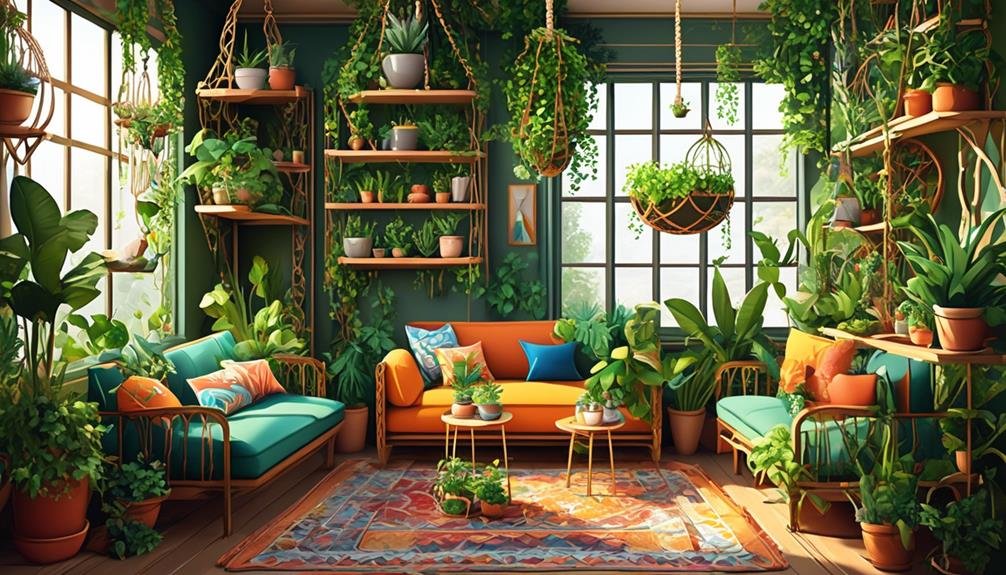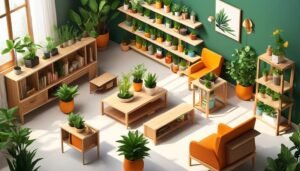You might think that making environmentally friendly home decor choices means sacrificing style and quality, but that doesn't have to be the case.
By making a few simple changes, you can create a beautiful and sustainable living space that reflects your personal taste.
From choosing sustainable materials to incorporating indoor plants, there are numerous ways to make your home decor choices more environmentally friendly.
So, if you're ready to transform your space into an eco-friendly haven, keep reading to discover some practical and stylish tips.
Key Takeaways
- Opt for sustainable materials such as reclaimed or recycled furniture, natural fibers, and eco-friendly flooring options.
- Embrace minimalism to reduce waste, create a visually pleasing and organized space, and save energy.
- Consider buying secondhand or vintage pieces to add character, support local businesses, and reduce resource consumption.
- Repurpose and upcycle old items to give them new life and reduce waste. Additionally, incorporate indoor plants and prioritize non-toxic and eco-friendly products for a healthier and greener home.
Choose Sustainable Materials
When selecting materials for your environmentally friendly home decor, opt for sustainable options that minimize your ecological footprint. Choosing sustainable materials is an essential step towards creating a more eco-friendly living space.
Start by looking for furniture made from reclaimed or recycled materials. These pieces not only reduce waste but also have a unique and rustic charm.
Another sustainable option is to use natural fibers like organic cotton, hemp, or bamboo for upholstery and curtains. These materials are renewable and biodegradable, making them a better choice for the environment.
When it comes to flooring, consider options such as bamboo, cork, or reclaimed wood, as they're sustainable alternatives to traditional hardwood.
Additionally, opt for paints and finishes that are low in volatile organic compounds (VOCs) to reduce air pollution in your home.
Finally, don't forget to repurpose and upcycle items whenever possible. By giving new life to old objects, you can reduce waste and add a personal touch to your decor.
Making these sustainable material choices won't only help protect the environment but also create a healthier and more eco-friendly home for you and your family.
Embrace Minimalism
To further enhance your environmentally friendly home decor, consider embracing minimalism and decluttering your living space. Minimalism is not just a design trend; it is a way of life that promotes simplicity and sustainability. By adopting a minimalist approach to your home decor, you can reduce waste, save energy, and create a peaceful and calming environment.
One way to embrace minimalism is by decluttering your living space. Take inventory of your belongings and ask yourself if each item brings you joy or serves a purpose. If not, consider donating, selling, or recycling it. By reducing the number of items in your home, you can minimize waste and create a more visually pleasing and functional space.
To help you visualize the benefits of minimalism, here is a comparison between a cluttered space and a minimalist space:
| Cluttered Space | Minimalist Space |
|---|---|
| Overwhelming | Calming |
| Chaotic | Organized |
| Distracting | Focused |
| High-maintenance | Low-maintenance |
Opt for Secondhand or Vintage Pieces

Consider incorporating secondhand or vintage pieces into your home decor for a sustainable and unique touch. By opting for secondhand or vintage items, you not only reduce waste but also add character to your space. Here are some reasons why choosing secondhand or vintage pieces is a smart choice:
- Reduced environmental impact: Buying secondhand or vintage items helps reduce the demand for newly manufactured products, which in turn reduces the use of natural resources and energy consumption associated with production.
- Unique and one-of-a-kind: Secondhand and vintage pieces often have a story to tell. They add a sense of history and individuality to your home, making it stand out from the crowd.
- Cost-effective: Secondhand items are often more affordable than their brand-new counterparts. You can find high-quality pieces at a fraction of the cost, saving both your wallet and the environment.
- Supporting local businesses and charities: When you buy secondhand, you're often supporting local thrift stores, antique shops, or charitable organizations. Your purchase not only benefits the environment but also helps these businesses and charities thrive.
Repurpose and Upcycle
Get creative and give new life to old items by repurposing and upcycling them in your home decor. Repurposing and upcycling not only contribute to a more environmentally friendly lifestyle but also add a unique touch to your living space. Instead of throwing away old furniture or decor items, consider how you can transform them into something new and functional. Here are some ideas to get you started:
| Old Item | Repurposed/Upcycled Idea |
|---|---|
| Wooden ladder | Turn it into a bookshelf or a towel rack |
| Mason jars | Use them as vases, candle holders, or storage containers |
| Vintage suitcases | Stack them to create a unique side table or storage unit |
| Wine bottles | Transform them into stylish lamps or planters |
Incorporate Indoor Plants

Incorporate indoor plants to add a touch of greenery and freshness to your home decor. Indoor plants not only enhance the aesthetic appeal of your space but also offer numerous benefits for your health and well-being.
Here are four ways you can incorporate indoor plants into your home decor:
- Choose low-maintenance plants: Opt for plants that are easy to care for and require minimal attention. Examples include snake plants, pothos, and ZZ plants. These plants aren't only beautiful but also thrive in different lighting conditions.
- Create a plant wall: Transform a blank wall into a stunning display of greenery by creating a plant wall. Hang a variety of plants in different sizes and shapes using wall-mounted planters. This not only adds visual interest but also helps improve air quality.
- Use plants as centerpieces: Instead of traditional flower arrangements, use potted plants as centerpieces on your dining table or coffee table. This not only brings life to the space but also provides long-term beauty.
- Incorporate hanging plants: Hang plants from the ceiling or place them on high shelves to add depth and visual interest to your decor. Hanging plants like spider plants or ferns can create a cascading effect, making your space feel lush and inviting.
Use Non-Toxic and Eco-Friendly Products
When selecting home decor items, prioritize non-toxic and eco-friendly products to create a healthier and more sustainable living environment. By opting for non-toxic materials, you can reduce the amount of harmful chemicals released into your home, promoting better indoor air quality and protecting your health.
Look for products that are labeled as low or zero VOC (volatile organic compounds) to ensure that they don't emit harmful gases. Additionally, choose eco-friendly materials such as reclaimed wood, bamboo, or organic cotton, which have a lower environmental impact compared to their conventional counterparts. These sustainable options help conserve natural resources and reduce deforestation.
When shopping for furniture or textiles, check for certifications like FSC (Forest Stewardship Council) or GOTS (Global Organic Textile Standard) to ensure that they meet strict environmental and social criteria. Furthermore, consider using natural cleaning products, as they're free from harsh chemicals that can harm both your health and the environment.
Making these conscious choices won't only create a healthier home but also contribute to a more sustainable future.
Frequently Asked Questions
How Can I Incorporate Indoor Plants Into My Home Decor?
To incorporate indoor plants into your home decor, choose low-maintenance options like pothos or snake plants. Place them near windows for sunlight, water regularly, and use eco-friendly pots. They add greenery and purify the air!
What Are Some Examples of Sustainable Materials That Can Be Used for Home Decor?
To make more environmentally friendly home decor choices, consider using sustainable materials like bamboo, reclaimed wood, and organic textiles. These options not only look stylish but also contribute to reducing your carbon footprint.
Where Can I Find Secondhand or Vintage Pieces for My Home Decor?
You can find secondhand or vintage pieces for your home decor at thrift stores, online marketplaces like eBay or Etsy, garage sales, estate sales, and even local classified ads.
How Can I Repurpose and Upcycle Items to Create Environmentally Friendly Home Decor?
Repurpose and upcycle items for eco-friendly home decor. Get creative with old furniture, use mason jars as vases, or turn wine corks into coasters. Reduce waste and give new life to old things.
What Are Some Non-Toxic and Eco-Friendly Products That I Can Use for My Home Decor?
Use non-toxic and eco-friendly products for your home decor. Look for items made from sustainable materials, such as bamboo or reclaimed wood. Avoid harmful chemicals by opting for natural paints and finishes.
Conclusion
In conclusion, making more environmentally friendly home decor choices isn't only beneficial for the planet, but also for creating a healthier living space.
By choosing sustainable materials, embracing minimalism, opting for secondhand or vintage pieces, repurposing and upcycling, incorporating indoor plants, and using non-toxic and eco-friendly products, you can significantly reduce your environmental impact and create a more sustainable and stylish home.
Start making these small changes today and make a big difference for the future.



